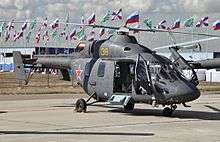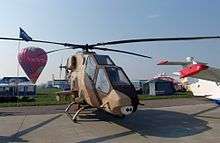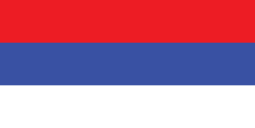Kazan Ansat
The Kazan Ansat is a Russian light, multipurpose helicopter manufactured by Kazan Helicopters.
| Ansat | |
|---|---|
.jpg) | |
| A Kazan Ansat | |
| Role | Multipurpose utility helicopter |
| Manufacturer | Kazan Helicopters |
| First flight | 17 August 1999 |
| Introduction | 28 August 2013 |
| Status | In service |
| Primary user | Russian Air Force |
| Produced | 1998–present |
History
Kazan Helicopters in Kazan, Tatarstan, Russia has been one of the main Russian manufacturers of helicopters of the Mikhail Mil bureau design. In the 1990s management realized that there would be a need for light helicopters in Russia, as the fleet of standard Mi-2's was getting older, and the design itself became obsolete. The Mi-2 was the lightest helicopter in large-scale use in the former USSR, despite being larger than most light Western helicopters. At first Kazan Helicopters wanted to develop a helicopter based on the AS 350 Ecureuil in cooperation with Eurocopter, but it failed. As a result, in 1993 Kazan Helicopters organized its own design bureau in order to create a new helicopter (the bureau was officially certified by the Russian authorities in January 1997, designer Valery Dvoeglazov). The helicopter was named Ansat (meaning "light", "simple" or "easy" in the Tatar language).[1]
In 1998 the first prototype for ground static tests was completed. The second prototype (no. 02, then 902) first flew on August 17, 1999, but the first official flight was made on October 6, 1999. It was powered by two Pratt & Whitney Canada PW206 engines. Another prototype, with a longer and slimmer fuselage, and powered by two PW207K engines, flew on December 27, 2001 (no. 03, then 904). From 2002 it was undergoing the certification process. The third prototype introduced clam shell doors for the cabin opening upwards and downwards, instead of the sliding ones. It was offered as the Ansat-U military trainer variant with dual controls. As of 2005, apart from the fourth prototype, no further Ansat's had yet been built.
In September 2001,[2] the Ansat-U won a contest for a trainer helicopter for the Russian Air Force. By 2010 four were in service with the Russian Air Force's Syzran Military Pilot Flying Training School. A further 20 are planned, to be powered by Ukrainian Motor Sich MS-500V engines replacing the Pratt & Whitney engines of the first four Ansats.[3] New light multi-purpose civilian helicopter "ANSAT" with hydromechanical control system of JSC "Kazan Helicopter Plant" has received type certification of Aviation Register of the Interstate Aviation Committee (IAC) on 28 August 2013.[4] Type Certificate of IAC AR, allowing (freight) helicopters to begin commercial operation, was obtained in August 2013. In December 2014, IAC AR issued the approval of the main changes (addition to the type certificate), allowing for the transportation of the passengers on the commercial market. The emergence of medical options was the final step in creating a unified helicopter, certified for transport and medical works, transportation of people. Earlier, versions of these helicopters were used by the Ministry of Defense, Ministry of Emergency Situations, Ministry of Internal Affairs, FSB and other state structures of Russia.[5]
_cockpit.jpg)
VIP version of Ansat helicopter was certified on 31 December 2015 and with a cabin in the style of the Aurus luxury cars brand in early February 2020.[6] The helicopter is equipped with hydromechanical control system and its passenger cabin can accommodate up to seven energy-absorbing passenger seats. There is also a ventilation and air conditioning systems. According to General Director at Kazan Helicopter Plant Vadim Ligai, work is underway to modernize helicopter's fuel system and install additional 200 kg fuel tanks in order to increase its flight range.[7]
On 28 October 2016, Russian Helicopters has presented a civilian version of Ansat helicopter.[8]
In 2017–2018, the helicopter has been certified for operation under extremely cold and high temperatures from minus 45°С to plus 50°С, during series of ground and flight testing.[9] In January 2019, on the basis of trials conducted at the Mount Elbrus in 2018, the Federal Air Transport Agency certified the increase in take-off/landing altitude of the Ansat from previous 1,000 m to 3,500 m and approved the helicopter for high-altitude operations.[10] Ansat helicopter optional Emergency Floatation System certified in March 2020.[11] Since May 2020, a specially-adapted medical version is used to transport patients with the novel coronavirus in Russia.[12]
Procurement
The Russian Defence Ministry placed an order for eight Ansat-U military helicopters in 2009–2010, becoming the initial launch customer of the variant. On 1 March 2011, it has ordered additional 32 Ansat-U helicopters. Under a third contract signed on 5 June 2017, ten more Ansat-U helicopters were ordered. Russian Air Force received the last batch of Ansat-U helicopters on 20 December 2017. All Ansat helicopters of the Russian Air Force are operated by the Syzran Higher Military Aviation School, a branch of the Zhukovsky – Gagarin Air Force Academy.[13]
On 22 May 2015, during the VIII International Helicopter Industry Exhibition HeliRussia 2015, Russian Helicopters has concluded two contracts for supply of five modernized light passenger Ansat helicopters. Three of these helicopters will be delivered to the Tatarstan airline Tulpar Helicopters and two to the Vector Aviation company.[14]
On 27 December 2016, Russian Helicopters and State Transport Leasing Company (GTLK) agreed on supply of six Ansat helicopters equipped with medical modules.[15] GTLK has ordered additional 31 medical helicopters, including 12 Ansat on 6 December 2017.[16] The deliveries of the later were completed in 2018.[17] These helicopters are operated by the Russian Helicopter Systems company as emergency medical service transports.[18]
During the 2018 Hydroaviasalon exhibition, subsidiaries of Rostec State Corporation — Russian Helicopters, National Service of Medical Aviation and Avia Capital Services LLC — signed a contract to supply 104 Ansat and 46 Mi-8AMT medically equipped helicopters.[19]
Russian Helicopters and Chinese Association for Disaster & Emergency Rescue Medicine (CADERM) inked a contract for supply of 20 Ansat helicopters at the Airshow China 2018 exhibition.[20][21] The helicopter was certified in China in early 2020.[22]
On 16 May 2019, within the XII International Helicopter Industry Exhibition HeliRussia 2019, Russian Helicopters and Polar Airlines signed a contract for supply of seven Ansat helicopters.[23]
On 20 January 2020, Eritrea has ordered two Ansat-U military helicopters with deliveries scheduled for 2020.[24]
The Interior Ministry of the Serbian Republic in Bosnia and Herzegovina ordered 3 Ansat helicopters for its Police force in early 2020 with deliveries planned for 2020-22.[25]
Design
The Ansat is of a classic construction. It takes a pilot and 10 passengers (one of them sits next to the pilot). The fuselage has a pair of doors in pilot's cab, and a pair of upwards and downwards opening side doors in transport compartment. After the seats have been removed, it can take 1000 kg of cargo inside. On external hook, it can take 1300 kg of load. It is powered with two PW207K turboshaft engines, which produce 630 shp each. It features a four-blade main rotor and two-blade tail rotor.
Variants

- Ansat
- Basic version, 2 prototypes built.
- Ansat-M
- Modernised Ansat with reduced empty weight and increased fuel. Series production planned from 2022.[26]
- Ansat-NT
- Proposed further modified next-generation version, powered by two 520 kW (700 shp) Klimov VK-650V turboshaft engines and with new four- or five-bladed main rotor.[26]
- Ansat-O
- Flying laboratory for testing of avionic equipment for naval helicopters.
- Ansat-U
- Special military-training version with three-wheel chassis and double-winged cargo doors.
- Ansat-UM
- Military medevac for 4 stretchers.
- Ansat-1K
- Version certified only for cargo transport.
- Ansat-1M
- Version with hydro-mechanical control system KSU-A instead of the fly-by-wire control system.
Derivatives

- Kazan Ansat-2RC
- Derived from the civilian version and equipped with a 12.7mm (0.5 inch) machine gun above the front skid support, as well as four hardpoints spread across two stub wings. The company has already displayed the helicopter carrying a mixture of rocket launcher tubes, bombs and anti-aircraft missiles.[27]
Operators
- Russian Aerospace Forces[26]
- Ministry of Emergency Situations[28]
- Tulpar Helicopters[14]
- Vector Aviation[14]
- Russian Helicopter Systems[17]
- Polar Airlines[23]
- Rostec State Corporation[19]
- Russian Helicopters[8]
- National Service of Medical Aviation
- Avia Capital Services LLC

- Chinese Association for Disaster & Emergency Rescue Medicine[20]



Specifications
Data from Jane's All The World's Aircraft 2003–2004,[2] Russian Helicopters[30]
General characteristics
- Crew: 1–2
- Capacity:
- 7–8 passengers
- 2 stretchers and 3 attendants
- 1,234 kg (2,721 lb) internal
- Length: 13.76 m (45 ft 2 in)
- Height: 3.4 m (11 ft 2 in)
- Empty weight: 1,900 kg (4,189 lb)
- Gross weight: 3,000 kg (6,614 lb)
- Max takeoff weight: 3,600 kg (7,937 lb)
- Powerplant: 2 × Pratt & Whitney Canada PW207K turboshaft engines, 470 kW (630 shp) each
- Main rotor diameter: 11.5 m (37 ft 9 in)
- Main rotor area: 103.87 m2 (1,118.0 sq ft)
Performance
- Maximum speed: 275 km/h (171 mph, 148 kn)
- Cruise speed: 220 km/h (140 mph, 120 kn)
- Never exceed speed: 285 km/h (177 mph, 154 kn)
- Range: 515 km (320 mi, 278 nmi)
- Endurance: 3 hours 20 minutes
- Service ceiling: 4,800 m (15,700 ft)
- Rate of climb: 21.5 m/s (4,230 ft/min)
See also
Aircraft of comparable role, configuration and era
References
| Wikimedia Commons has media related to Kazan Ansat. |
- Mladenov 2016, pp. 79–80.
- Jackson 2003, pp. 378–379.
- Mladenov 2010, p. 26.
- "Гражданский "Ансат" с ГМСУ получил сертификат АР МАК » Ресурс машиностроения. Машиностроение: новости машиностроения, статьи. Каталог: машиностроительный завод и предприятия". I-mash.ru. Archived from the original on 2017-10-30. Retrieved 2017-06-23.
- "«Ансат» и Ка-226Т производства «Вертолетов России» вышли на российский рынок гражданской авиации". Armstrade.org. Archived from the original on 2019-01-30. Retrieved 2017-06-23.
- https://www.airrecognition.com/index.php/news/defense-aviation-news/2020/february/5984-rostec-is-ready-to-start-deliveries-of-the-ansat-aurus-helicopter.html
- "Вертолет «Ансат» сертифицирован в VIP версии". armstrade.org. 31 December 2015. Archived from the original on 7 September 2017. Retrieved 15 February 2020.
- "В Подмосковье представили первый гражданский «Ансат»". helicopter.su. 28 October 2016. Archived from the original on 23 October 2017. Retrieved 22 October 2017.
- "Archived copy". Archived from the original on 2018-06-04. Retrieved 2018-06-02.CS1 maint: archived copy as title (link)
- "Archived copy". Archived from the original on 2019-01-30. Retrieved 2019-01-30.CS1 maint: archived copy as title (link)
- http://airrecognition.com/index.php/news/defense-aviation-news/2020/march/6036-ansat-helicopter-got-a-certificate-for-the-emergency-floatation-system.html
- https://sputniknews.com/military/202007111079857817-russian-helicopters-shows-off-medical-ansat-capable-of-transporting-covid-19-patients---photo/
- "Министерство обороны России получило десять новых вертолетов "Ансат-У"". bmpd.livejournal.com. 21 December 2017. Retrieved 15 February 2020.
- "«Вертолеты России» заключили первые контракты на поставку легких вертолетов «Ансат»". armstrade.org. 22 May 2015. Archived from the original on 26 June 2017. Retrieved 15 February 2020.
- "Контракты Государственной транспортной лизинговой компании на поставку авиационной техники". bmpd.livejournal.com. 1 January 2017. Retrieved 15 February 2020.
- "ГТЛК подписала контракты на закупку еще 31 медицинского вертолета". bmpd.livejournal.com. 7 December 2017. Retrieved 15 February 2020.
- ""Вертолеты России" поставили в 2018 году 31 медицинский вертолет". bmpd.livejournal.com. 31 December 2018. Retrieved 15 February 2020.
- "AIRCRAFT FLEET". helisystems.ru. Retrieved 15 February 2020.
- "Russian Helicopters lands massive order for 152 medical helicopters". airecognition.com. 8 November 2018. Archived from the original on 13 September 2018. Retrieved 9 January 2018.
- "Russian Helicopters lands new Ansat order in China". airrecognition.com. 8 November 2018. Retrieved 15 February 2020.
- "China purchases 20 Ansat aircraft at Airshow China". TASS. 8 November 2018. Archived from the original on 9 November 2018. Retrieved 9 November 2018.
- http://airrecognition.com/index.php/news/defense-aviation-news/2020/february/5978-rostec-ready-to-commence-ansat-supplies-to-china.html
- ""Вертолеты России" поставят "Полярным авиалиниям" семь вертолетов Ансат". russianhelicopters.aer. 16 May 2019. Archived from the original on 24 May 2019. Retrieved 15 February 2020.
- "Россия поставит Эритрее два вертолета «Ансат» до конца 2020 года". armstrade.org. 20 January 2020. Retrieved 15 February 2020.
- https://armstrade.org/includes/periodics/news/2020/0625/112558453/detail.shtml
- Butowski Air International July 2020, p. 30.
- "Kazan Ansat-2RC – Kazan Helicopter Plant | Aviation Photo #0969245". Airliners.net. Archived from the original on 2017-10-23. Retrieved 2017-06-23.
- Broadbent Air International July 2020, p. 16.
- https://mondo.ba/Info/Drustvo/a968462/RS-prva-u-Evropi-kupuje-ruske-helikoptere.html
- "Features: Ansat". Russianhelicopters.aero. Archived from the original on 2017-05-23. Retrieved 2017-06-23.
Bibliography
- Broadbent, Mark. "Rotary Focus: Ansat for emergency services". Air International, July 2020, Vol. 99, No. 1. p. 16. ISSN 0306-5634.
- Butowski, Piotr. "Russian Review: New designations for Ansat". Air International, July 2020, Vol. 99, No. 1. p. 30. ISSN 0306-5634.
- Jackson, Paul. Jane's All The World's Aircraft 2003–2004. Coulsdon, UK: Jane's Information Group, 2003. ISBN 0-7106-2537-5.
- Mladenov, Alexander. "Re-engined Ansat for Russia". Air International, November 2010, Vol 79 No 5. p. 26. ISSN 0306-5634.
- Mladenov, Alexander. "Ansat". Air International, February 2016, Vol 90, No. 2. pp. 78–82. ISSN 0306-5634